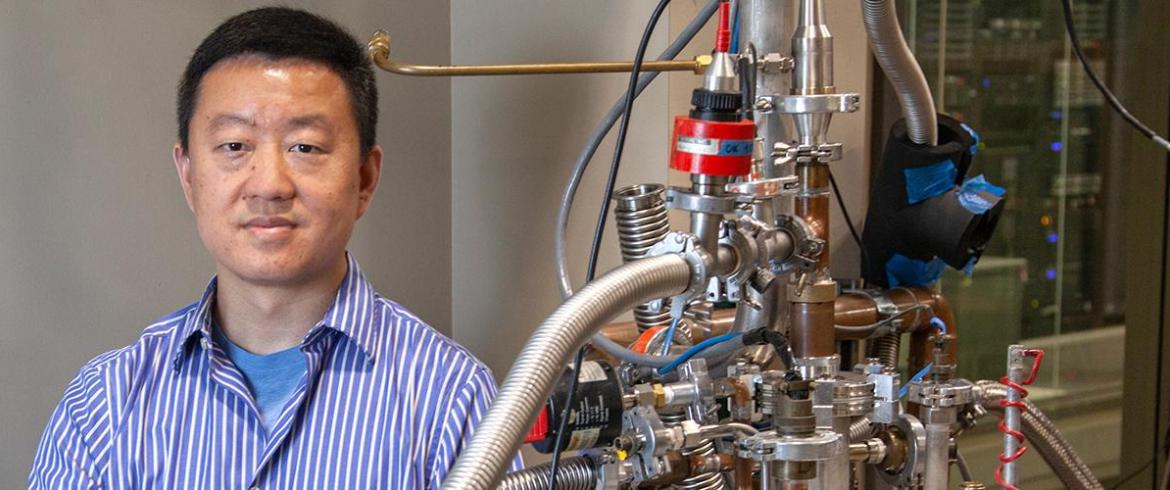
Understanding the usefulness of one of the world’s weirdest fluids
After pioneering research into the properties of superfluid helium, known as He II, researchers at the FAMU-FSU College of Engineering cryogenics lab are now developing practical applications using what principal investigator Wei Guo, Ph.D. calls this “very bizarre” substance.
Some of us learned about the three standard heat transfer methods— conduction, convection and radiation— in physics class.
“But heat transfer in He II is via a completely different, extremely effective, heat transfer mode called thermal counterflow,” said Guo, an associate professor in mechanical engineering at the college.
“At low temperatures, it has heat transfer capability much, much higher than that of a pure metal like gold,” he explained. “For this reason, He II has been widely utilized as a coolant for superconducting magnets, satellites, medical instruments, and also large particle colliders and accelerators.”
To create He II, liquid helium must be cooled to just a few degrees below its boiling point of -269˚C. He II effectively consists of two fluid components: a normal viscous fluid component and the superfluid component. The superfluid has no viscosity, which means if you put some superfluid helium in a circular channel and give it a push, it would literally flow forever.
The extremely effective heat transfer of He II can be affected by turbulence in this two-fluid system. The main focus of Guo’s cryogenics lab is to develop novel visualization tools “so we can study the flows in this bizarre fluid and understand the effect of turbulence,” Guo said.
“ When we do our research we need cryogenic fluids like liquid nitrogen and liquid helium and other things. Those cryogens can be produced at the MagLab, a big advantage. Otherwise it’s very challenging to do this kind of very-low-temperature fluid research.”
One tool, called particle tracking velocimetry, is based on the use of frozen particle tracers for velocity field measurement. For instance, by injecting hydrogen gas into cold liquid helium, the hydrogen will condense and form micron-sized ice particles in the fluid. These ice particle tracers move with the viscous normal fluid in He II, but can also get trapped onto the vortices—little tornadoes—in the viscosity-less superfluid.
For flows in He II where the two fluids move in different directions, such as in thermal counterflow, the behavior of the micron-sized tracers can become difficult to interpret. This led the lab to develop another technique, called molecular tagging velocimetry.
Seeking the smallest tracer possible, scientists looked to molecules. By “exciting” a helium atom using strong yet extremely short femtosecond (i.e., 10-15s) laser pulses, the team can create a line of metastable helium molecules in liquid helium and treat them as tracers.
“The cool thing is that those molecules are so small that they either move with the viscous normal fluid above 1˚Kelvin or bind to and move with the vortices in the superfluid below about 0.6˚K. Their simple behavior allows us to make accurate flow field measurements,” he said.

A MagLab neighbor, the Florida Center for Advanced Aero- Propulsion (FCAAP) is interested in the possibilities of a “cryogenic wind tunnel” to be used in their research measuring turbulence. The motivation of such a tunnel is for model testing in turbulent flows with extremely high Reynolds numbers.
“Compared to conventional fluid materials such as water and air, cryogenic helium has much smaller kinematic viscosity,” Guo said. “You can produce turbulent flows using cryogenic helium in compact equipment with Reynolds numbers that match that in real turbulent flows, such as those generated by airplanes and submarines.”
One implementation is using superconducting magnets to levitate a model of a submarine or an airplane wing in the helium for non-invasive flow measurements.
Another application would be in particle accelerators. Many modern particle accelerators utilize superconducting cavities to accelerate charged particles. There is a strong demand to reach higher accelerating fields so that the particles can gain higher energies over shorter distances. The prospect of shorter accelerator beamlines is significant due to their high costs— on the order of 1 billion U.S. dollars per mile.
The maximum accelerating field is limited by “cavity quenching” caused by heating from tiny surface defects. By locating and subsequently removing those defects, the maximum acceleration can be significantly improved. There is a long-standing research effort in the accelerator field to develop reliable methods to detect those sub-millimeter defects.
Using molecular tagging velocimetry, Guo posited that a tracer line would deform wherever there might be a hot spot in He II.
“This idea indeed worked very nicely in our recent tests,” he said. “We could see deformation of the tracer line on top of a hot spot. Based on the analysis of this deformation, we can locate the hot spot with an accuracy far better than other existing methods.”
Guo took over the lab after the retirement of Emeritus Professor Steven Van Sciver, who created the facility and literally wrote the book on helium cryogenics.
The cryogenics lab is still sited in the MagLab building, located nearby in the same research park as the College of Engineering.
“Originally, the cryogenics lab conducted testing work and provided technical support for the design of the cooling systems for the superconducting magnets at the MagLab,” Guo said. “This lab gradually evolved into a more independent research site. We have secured sustained external funding support from federal funding agencies.”
“Because of FAMU-FSU Engineering’s unique location in Innovation Park, many valuable resources are available to us,” he said. “For instance, our research requires large amounts of cryogenic fluids like liquid nitrogen and liquid helium and other things. These cryogens can be easily procured from the MagLab. It would be challenging to conduct this kind of low-temperature fluid research elsewhere.”
